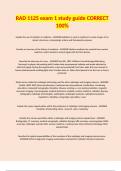RAD 1125 exam 1 study guide CORRECT
100%
Explain the use of radiation in medicine - ANSWER Radiation is used in medicine to create images of an
atomic structures or physiologic actions and therapeutic purposes
Provide an overview of the history of medicine - ANSWER Modern medicine has evolved from ancient
medicine, which started in ancient Egypt with the first doctors
Describe the discovery of x-rays. - ANSWER Nov 8th, 1895. Wilhelm Conrad Rontgen(Wurzburg,
Germany) in physics lab working with Crookes tube encompassed cathode and anode attached to
electrical supply. During the experiments, x-rays were produced from tube. plate that was covered in
barium platinocyanide emitting light when Crookes tube on. When hand placed in bw the two an Xray is
produced.
Define terms related to radiologic technology and the other radiologic and imaging sciences - ANSWER
ALARA, ARRT, ASRT, Bone densitometry, Cardiovascular-interventional, Certification, Continuing
education, Computed tomography, Discipline, Disease, ionizing vs. non-ionizing radiation, magnetic
resonance imaging, mammography, medical dosimetry, modality, nuclear medicine, radiation therapy,
radiography, radiologic technologists, radiologists, radiologist assistants, radiopharmaceutical,
regulations, shielding, sonography, specialties, x-rays
Explain the career opportunities within the profession of radiologic and imaging sciences - ANSWER
Hospitals, freestanding clinics, research, sales, marketing
Identify the various specialties within a radiologic and imaging sciences department - ANSWER
Radiography, CT scanning, medical sonography, radiation therapy, MRI scanning, mammography, DEXA
scanning, radiologist assistant (RA), nuclear medicine, cardiovascular interventional technology, PACS
administrator
Describe the typical responsibilities of the members of the radiologic and imaging sciences team -
ANSWER Perform diagnostic imaging examinations and perform radiation therapy treatments
, Explain the career-ladder opportunities within radiologic and imaging sciences. Discuss the roles of other
members of the health care team. - ANSWER Economic gatekeeping, political advocacy, public health
delivery, patient safety, quality of care improvement, and information technology.
Analyze and determine appropriate actions for situations that require critical thinking. - ANSWER Any
time a situation arises that requires a difficult or uncomfortable decision, one must apply these steps:
identify the problem, investigate the problem, formulate viable solutions to the problem, and select the
best solution.
Identify professional situations that use critical-thinking and problem-solving skills. - ANSWER An
example of a professional situation that would require critical thinking would be in the case of deciding
whether you should allow your patient to stand if they say they are feeling a bit weak.
Develop critical-thinking and problem-solving skills as a radiologic sciences professional. - ANSWER These
skills are often developed during role playing activities and during clinical activities.
Explain the purpose of clinical education in radiologic and imaging sciences - ANSWER It provides a
structured and ordered mechanism for the student to develop and refine the important skills needed in
a variety of one-on-one, direct interaction la with the patient.
Describe the steps students may experience in the development of their clinical education skills -
ANSWER students progress in their clinical skills by first observing, then assisting, and finally performing
diagnostic or therapeutic procedures.
Identify the types of supervision necessary to assure safety in the clinical setting - ANSWER Indirect
supervision: requires a qualified radiographer reviews, evaluates, and approves the procedure. A
supervisor isn't present at all times.
Direct supervision: requires a qualified radiographer to be physical present with student during imaging.
Describe aspects of assessment used to measure and document student performance during clinical
education - ANSWER students are assessed via competency evaluations for specific procedures or
treatments.




